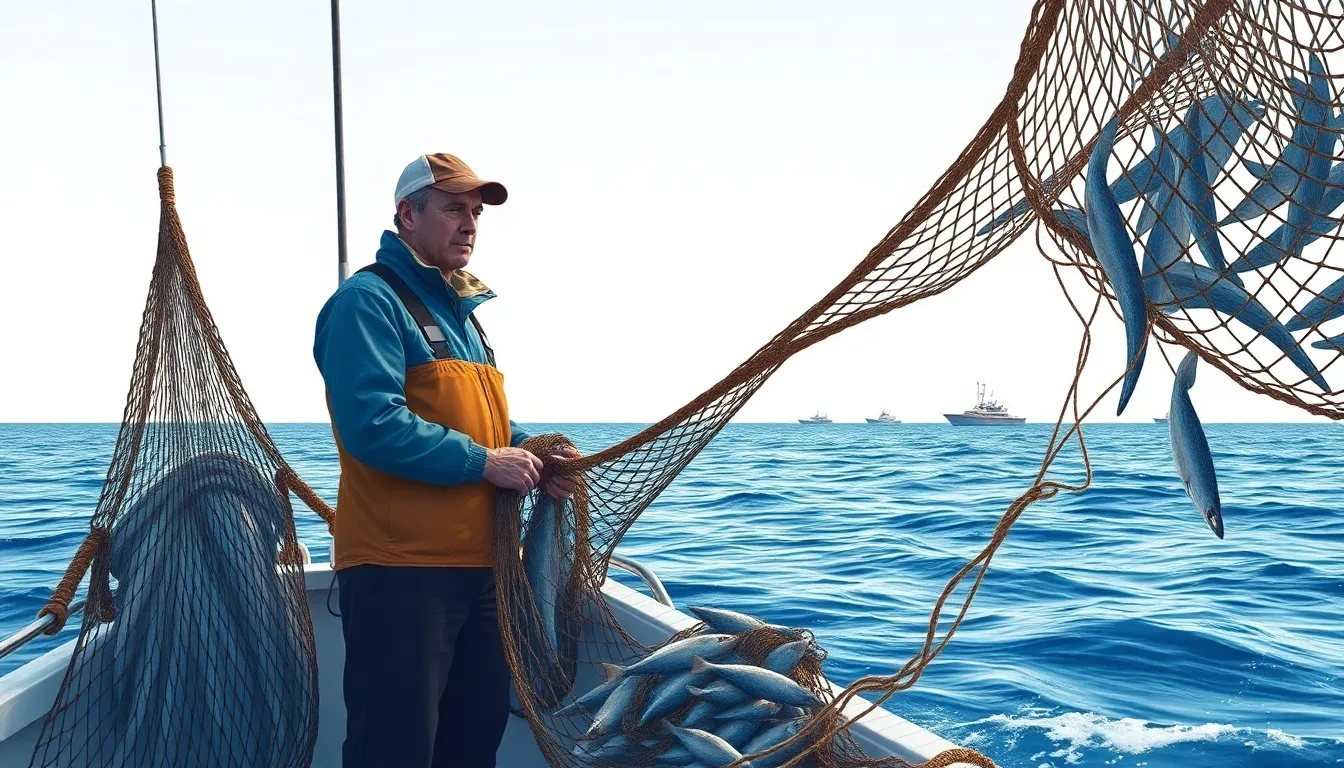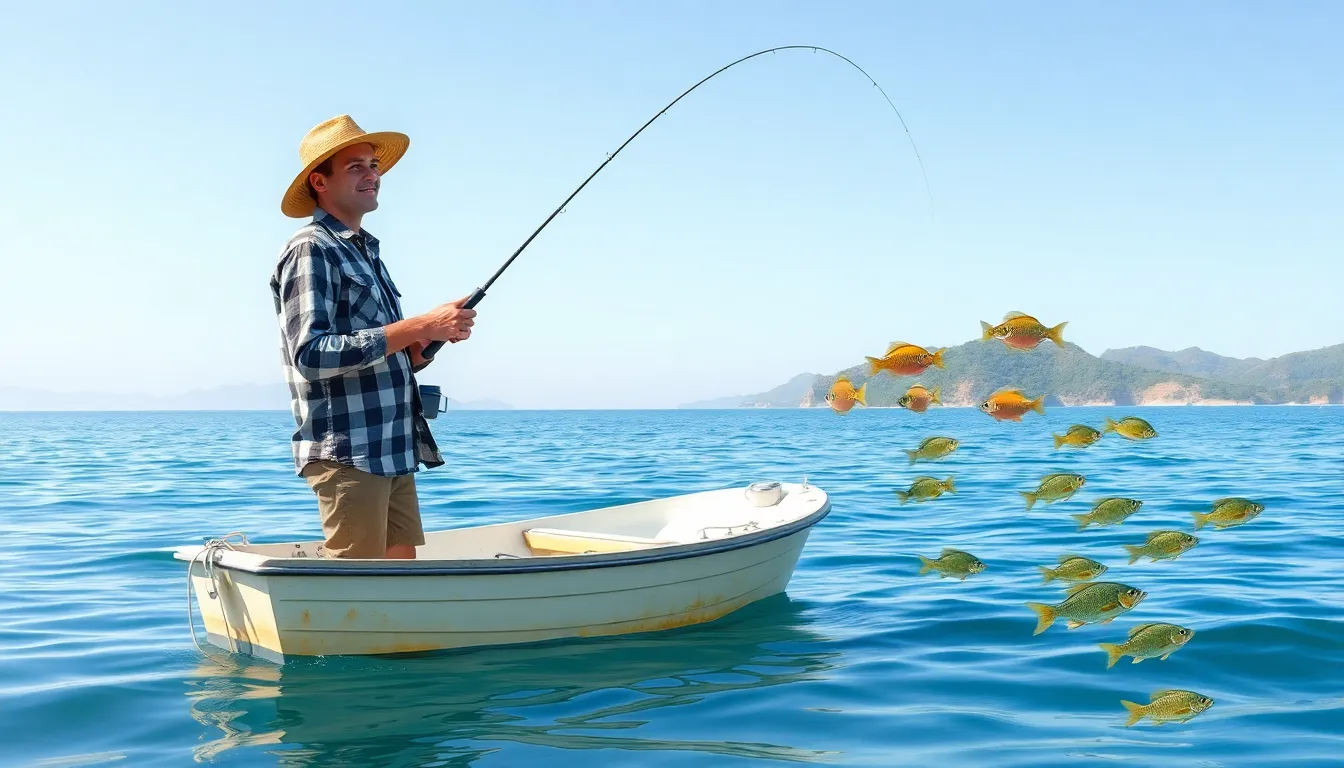Imagine a world where fish are plentiful, oceans sparkle, and dinner plates boast the freshest catch without guilt. Sustainable fishing isn’t just a trendy buzzword; it’s a lifeline for our oceans and future generations. As fish populations dwindle and ecosystems face mounting pressure, the call for responsible fishing practices has never been louder.
Table of Contents
ToggleUnderstanding Sustainable Fishing
Sustainable fishing focuses on practices that maintain fish populations and contribute to healthy ocean ecosystems. This approach safeguards marine life for future generations while addressing the urgent challenges affecting our oceans.
Definition and Principles
Sustainable fishing refers to methods that allow fish populations to replenish while minimizing environmental impact. The core principles include maintaining habitat integrity, using selective fishing gear, and adhering to catch limits. These practices ensure an equilibrium between fishing activities and marine ecosystems. Monitoring fish stocks helps assess population health, guiding sustainable management decisions. By promoting responsible fishing, communities can enjoy fishery resources without compromising future availability.
Importance of Sustainability in Fisheries
Sustainability in fisheries plays a crucial role in preserving marine biodiversity. Declining fish populations threaten food security for millions who rely on fishing as a livelihood. Implementing sustainable practices reduces overfishing, enabling ecosystems to recover. Protecting habitats also enhances fisheries’ resilience against environmental changes. Economic benefits arise from sustainable fisheries through increased stock yields and tourism. Research indicates that sustainable practices can lead to healthier fish populations and more robust ocean ecosystems, ensuring continued access to marine resources for years to come.
Current Challenges in Fishing Practices

Fishing practices face several challenges that threaten the sustainability of marine resources. Overfishing remains a major concern, with many fish stocks dwindling due to excessive catch limits. Global demand for seafood leads to the depletion of species such as tuna and cod. Artisanal and commercial fishers often struggle to balance economic needs with conservation efforts. According to the Food and Agriculture Organization, around 34% of global fish stocks are overfished, indicating an urgent need for effective management and regulation.
Bycatch poses another significant challenge, impacting marine life and ecosystems. Many fishing methods unintentionally catch non-target species, leading to significant mortality rates among dolphins, sea turtles, and seabirds. Estimates suggest that about 40% of the total catch in commercial fisheries is bycatch, resulting in substantial waste. This not only disrupts marine biodiversity but also reduces overall fish populations, making it challenging to achieve sustainable fishing goals. Fishermen must adopt selective fishing practices to minimize bycatch and protect vulnerable species.
Practices Promoting Sustainable Fishing
Sustainable fishing practices contribute significantly to preserving marine ecosystems and fish populations. Various methods exist that support this vital effort.
Eco-Friendly Techniques
Selective fishing gear, such as circle hooks and traps, minimizes bycatch, protecting non-target species. These techniques enhance catches while reducing harm to marine life. Utilizing fish aggregating devices helps target specific fish species, further limiting unintended catches. Implementing seasonal closures and spatial restrictions can also allow fish populations to recover during breeding seasons. Incorporating habitat-friendly practices, like avoiding destructive bottom trawling, fosters healthier ocean environments. By integrating these eco-friendly techniques, fisheries can significantly reduce their environmental footprint and support biodiversity.
Regulatory Measures and Certifications
Governments around the world implement regulations to promote sustainable practices in fisheries. These measures often include setting catch limits based on scientific assessments of fish stocks to prevent overfishing. Certifications from organizations like the Marine Stewardship Council indicate adherence to sustainability standards, encouraging consumers to make informed choices. Programs like Fishery Improvement Projects aim to improve existing fisheries over time, benefiting both marine life and fishing communities. Additionally, monitoring and enforcement ensure compliance with regulations, creating accountability among fishers. Adopting these regulatory measures and certifications enhances sustainable fishing and builds a more resilient ocean ecosystem.
Benefits of Sustainable Fishing
Sustainable fishing provides numerous benefits that enhance both the environment and local communities. Understanding these advantages promotes broader support for conservation efforts.
Environmental Advantages
Healthy fish populations contribute to balanced marine ecosystems. Biodiversity thrives as sustainable fishing practices protect habitats and reduce bycatch. Increased fish stocks support predator-prey relationships, fostering ecosystem stability. For example, implementing seasonal closures allows fish species to spawn and replenish their populations, strengthening long-term sustainability. Additionally, sustainable fishing methods minimize habitat degradation, preserving the integrity of underwater environments. As a result, marine ecosystems recover more efficiently, supporting the diverse life forms they harbor. Overall, sustainable fishing enhances resilience against climate change, ensuring healthier oceans for future generations.
Economic Impact on Communities
Economic benefits greatly impact communities that rely on fishing. Sustainable practices can lead to increased fish yields, supporting local economies and providing livelihoods. Fishermen using eco-friendly techniques frequently experience higher market values for responsibly sourced seafood. In particular, sustainable fisheries attract eco-tourism, drawing visitors interested in marine conservation and wildlife experiences. Furthermore, local jobs expand as demand for sustainable fish products rises, reinforcing economic stability. Community involvement in sustainable fishing initiatives fosters a sense of ownership and pride, which ultimately enhances conservation efforts. In this way, sustainable fishing not only protects resources but also enriches the lives of those who depend on them.
Future of Sustainable Fishing
Sustainable fishing relies on continued innovation and cooperation to thrive. Advancements in technology play a crucial role in shaping sustainable practices for the future.
Innovations in Technology
Smart fishing gear is revolutionizing how fishers operate. Electronic monitoring systems increase accountability by tracking catches and discarding practices. These systems help ensure compliance with regulations and improve data collection, leading to better management decisions. Artificial intelligence algorithms analyze fish populations and recommend sustainable catch limits, optimizing fisheries’ performance. Further, drones and underwater robots assess marine habitats, providing insights into ecosystem health. By integrating these technologies, the fishing industry can enhance sustainability while supporting fish stocks and biodiversity.
Role of Policy and Global Cooperation
Effective policies promote sustainable fishing practices and enable international collaboration. Governments worldwide implement regulations based on scientific assessments to preserve fish populations. Cooperation among nations is vital for managing shared fish stocks and ensuring compliance with sustainability standards. Organizations like the Food and Agriculture Organization facilitate discussions to address transboundary fishing issues and develop best practices. Through these collective efforts, countries can work together to combat overfishing, protect marine environments, and foster sustainable fishing practices globally. As a result, sustainable fishing becomes a collaborative endeavor essential for the future of ocean ecosystems.
Sustainable fishing is essential for the health of our oceans and the well-being of future generations. By adopting responsible practices, communities can ensure that fish populations thrive while minimizing environmental impact. The collaboration between fishers, policymakers, and consumers is crucial in promoting sustainability and protecting marine biodiversity.
As technology and innovative practices evolve, the potential for more effective fishing methods increases. These advancements not only support fish stock recovery but also enhance economic opportunities for fishing communities. Embracing sustainable fishing is a shared responsibility that benefits both the environment and local economies, paving the way for a resilient ocean ecosystem.





